Images of the Soul
Munch's
belief that art should be of people who breathe, who feel emotions, who suffer
and love' resulted in unprecedented images of the innermost feelings and mental
anguish of modern man.
When
Munch died, there was a copy of Dostoevsky's book The Devils by his bedside. It
seems a fitting choice for a man who created his own nightmare visions and who
provided the earliest pictorial definitions of paranoia and angst. Munch
himself did little to dispel this image, claiming that art was his life's
blood, costing him pain and suffering.
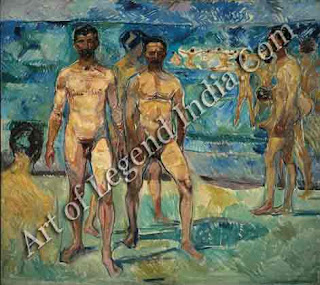 Initially,
his personal style was built up from his own subjective view of the world
around him. After his early naturalist phase, Munch's first important paintings
including The Sick Child were described as 'impressionistic' by the critics, at
a time when the word was used as a term of abuse. But rather than studying the
variations of light caused by the weather or the time of day, Munch chose to
concentrate on the momentary visual distortions that can occur as the eye
adjusts to different conditions in effect, tricks of the light. As a result,
most early commentators singled out Munch's apparently cavalier use of colour
for their criticisms.
Initially,
his personal style was built up from his own subjective view of the world
around him. After his early naturalist phase, Munch's first important paintings
including The Sick Child were described as 'impressionistic' by the critics, at
a time when the word was used as a term of abuse. But rather than studying the
variations of light caused by the weather or the time of day, Munch chose to
concentrate on the momentary visual distortions that can occur as the eye
adjusts to different conditions in effect, tricks of the light. As a result,
most early commentators singled out Munch's apparently cavalier use of colour
for their criticisms.
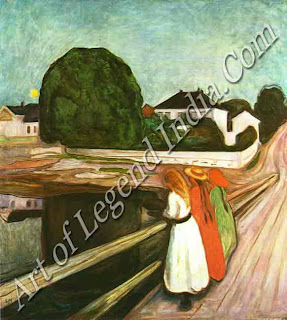 From
this position, it was a short step to progress from painting visual impressions
to depicting the effect that these impressions had on the emotions. The Scream
is the most famous example of this. Munch was inspired by a dramatic sunset
which he had witnessed while walking beside a fjord. However, by suppressing
his own features and by transforming the waters and the sky into threatening
shock waves of vibrant colour, he managed to convey the feelings of terror that
he had experienced on that occasion. Munch defended his approach by stressing
that 'Nature is the means, not the end. If one can attain something by changing
nature, one must do it.
From
this position, it was a short step to progress from painting visual impressions
to depicting the effect that these impressions had on the emotions. The Scream
is the most famous example of this. Munch was inspired by a dramatic sunset
which he had witnessed while walking beside a fjord. However, by suppressing
his own features and by transforming the waters and the sky into threatening
shock waves of vibrant colour, he managed to convey the feelings of terror that
he had experienced on that occasion. Munch defended his approach by stressing
that 'Nature is the means, not the end. If one can attain something by changing
nature, one must do it.
This
directness was reflected in Munch's method of working. When, for example, he
was commissioned to paint a portrait of the industrialist, Herbert Esche, Munch
did nothing for the first fortnight except stay with the family until he felt
he knew his subject. Then he set to work very rapidly, testing his colours on
his client's expensive wallpaper and relying on a simple charcoal sketch on the
canvas as his sole guide for the composition.
During
his Symbolist phase (c.1889-1900), Munch turned to the depiction of ideas
rather than emotions, using the mystical and sexual images that were
fashionable as the basis for his Frieze of Life. In fact, the very notion of a
frieze, with its attempt to simulate the resonant quality of music, was a
thoroughly Symbolist concept.
KEY IMAGES
For the
several components of his Frieze, Munch selected a few key images and reworked
them constantly, varying the colour schemes, the poses of the figures or even
just the titles. 'Art is crystallization' he asserted, convinced that his
revisions would eventually lead to the most powerfully emotive version of any
given theme.
In this
regard, Munch's interest in the graphic arts proved crucial. Originally, he had
taken up etching, in 1894, as a means of earning extra income. However, as the
possibilities of the medium became apparent to him, he grew more inventive and,
at one stage, even acquired the habit of carrying a copper plate around in his
pocket to use like a sketch book.
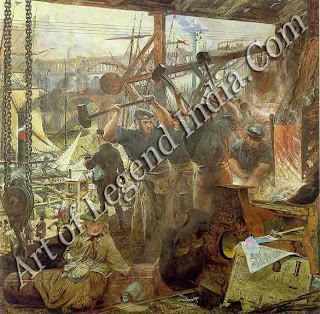 Munch's
work in Paris, in 1896, with Auguste Clot the printer who had aided Toulouse Lautrec
and Bonnard proved a revelation. He learnt the techniques of making lithographs
and colour woodcuts and, to the latter in particular, he brought exciting
innovations. By sawing the woodblock into smaller sections and colouring these
individually, he was able to produce multicoloured woodcuts easily, without going
through the tedious process of making separate printings for each colour.
Munch's
work in Paris, in 1896, with Auguste Clot the printer who had aided Toulouse Lautrec
and Bonnard proved a revelation. He learnt the techniques of making lithographs
and colour woodcuts and, to the latter in particular, he brought exciting
innovations. By sawing the woodblock into smaller sections and colouring these
individually, he was able to produce multicoloured woodcuts easily, without going
through the tedious process of making separate printings for each colour.
Prints
were invaluable to Munch because the plates or blocks could easily be reworked
or printed in different colours, thereby greatly increasing the scope for
experiment. There was also a degree of feedback, from the prints to his
canvases: compositions were often refined in lithographs or woodcuts and then
translated back into paint, producing a simplified and more powerful image. In
his later years, Munch grew increasingly reluctant to part with his paintings
and, where he was obliged to sell, frequently made replicas for himself.
In his
heart, he still nurtured hopes of displaying his works together, confident that
the full force of his very personal style could only be appreciated if viewed
en masse.
The
availability of his art to a wide public was of prime importance to Munch and,
in a sense, this single desire governed his interest in friezes, graphic work
and large murals. He despised the notion of a bourgeois art, where the
academies became factories for producing paintings which vanished into the
houses of the wealthy forever.
After
Munch's return to Norway in 1908 his paintings lost their emotional intensity,
and he turned to his native landscape, nature and working people for the
subjects of his work. These themes were central to his large-scale public
projects such as the University murals and the frieze at the Freia chocolate
factory. But even in his apparently realistic works, traces of his old
obsessions are still discernible. The bowed head of the model in his Nude by
the Wicker Chair carries faint echoes of the shy apprehension in Puberty, while
the workmen in Workers Returning Home have the same remorseless formality as
the faceless figures in Anxiety.
Munch was,
in every sense, an isolated figure. He had no pupils and he declined
invitations to join avant-garde groups like Die Brucke. Even to his bohemian
friends in Christiania and Berlin, he had remained something of an outsider.
However, his haunting images linking the themes of sickness, death and raw,
sexual power neatly encapsulated the mystical spirit of the Symbolists, while
the directness of his style, with its daringly inventive distortions, paved the
way for Expressionism.
Writer
– Marshall Cavendish
 Initially,
his personal style was built up from his own subjective view of the world
around him. After his early naturalist phase, Munch's first important paintings
including The Sick Child were described as 'impressionistic' by the critics, at
a time when the word was used as a term of abuse. But rather than studying the
variations of light caused by the weather or the time of day, Munch chose to
concentrate on the momentary visual distortions that can occur as the eye
adjusts to different conditions in effect, tricks of the light. As a result,
most early commentators singled out Munch's apparently cavalier use of colour
for their criticisms.
Initially,
his personal style was built up from his own subjective view of the world
around him. After his early naturalist phase, Munch's first important paintings
including The Sick Child were described as 'impressionistic' by the critics, at
a time when the word was used as a term of abuse. But rather than studying the
variations of light caused by the weather or the time of day, Munch chose to
concentrate on the momentary visual distortions that can occur as the eye
adjusts to different conditions in effect, tricks of the light. As a result,
most early commentators singled out Munch's apparently cavalier use of colour
for their criticisms.  From
this position, it was a short step to progress from painting visual impressions
to depicting the effect that these impressions had on the emotions. The Scream
is the most famous example of this. Munch was inspired by a dramatic sunset
which he had witnessed while walking beside a fjord. However, by suppressing
his own features and by transforming the waters and the sky into threatening
shock waves of vibrant colour, he managed to convey the feelings of terror that
he had experienced on that occasion. Munch defended his approach by stressing
that 'Nature is the means, not the end. If one can attain something by changing
nature, one must do it.
From
this position, it was a short step to progress from painting visual impressions
to depicting the effect that these impressions had on the emotions. The Scream
is the most famous example of this. Munch was inspired by a dramatic sunset
which he had witnessed while walking beside a fjord. However, by suppressing
his own features and by transforming the waters and the sky into threatening
shock waves of vibrant colour, he managed to convey the feelings of terror that
he had experienced on that occasion. Munch defended his approach by stressing
that 'Nature is the means, not the end. If one can attain something by changing
nature, one must do it.  Munch's
work in Paris, in 1896, with Auguste Clot the printer who had aided Toulouse Lautrec
and Bonnard proved a revelation. He learnt the techniques of making lithographs
and colour woodcuts and, to the latter in particular, he brought exciting
innovations. By sawing the woodblock into smaller sections and colouring these
individually, he was able to produce multicoloured woodcuts easily, without going
through the tedious process of making separate printings for each colour.
Munch's
work in Paris, in 1896, with Auguste Clot the printer who had aided Toulouse Lautrec
and Bonnard proved a revelation. He learnt the techniques of making lithographs
and colour woodcuts and, to the latter in particular, he brought exciting
innovations. By sawing the woodblock into smaller sections and colouring these
individually, he was able to produce multicoloured woodcuts easily, without going
through the tedious process of making separate printings for each colour. 
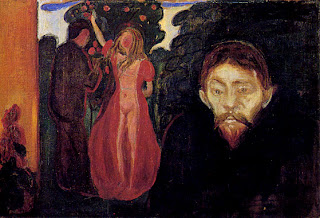
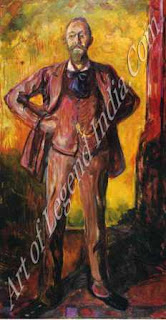
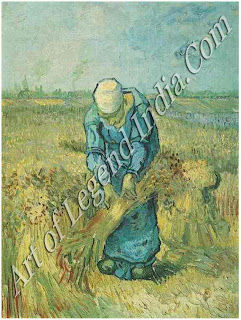










0 Response to "Norwegian Great Artist Edvard Munch - Image of the Soul"
Post a Comment